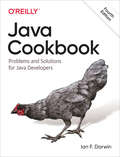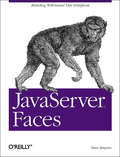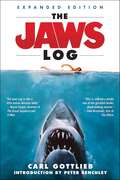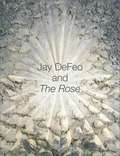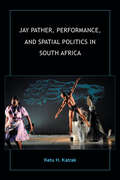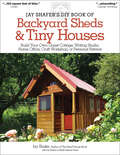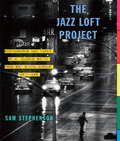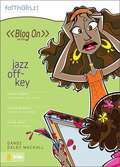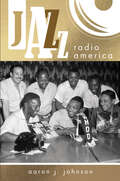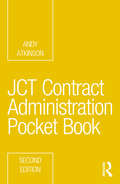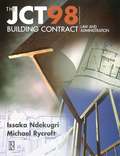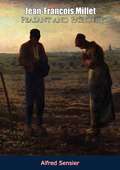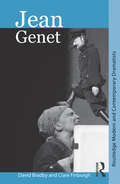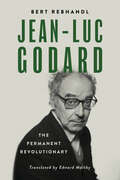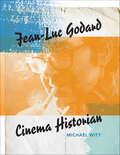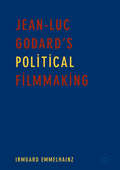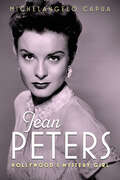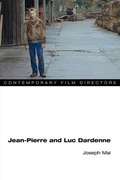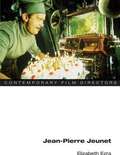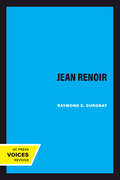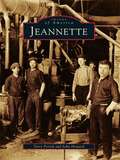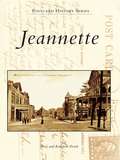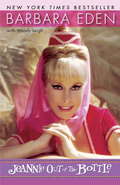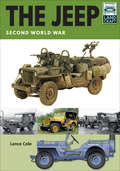- Table View
- List View
Java 2D Graphics
by Jonathan KnudsenJava 2D Graphics describes the 2D API from top to bottom, demonstrating how to set line styles and pattern fills as well as more advanced techniques of image processing and font handling. You'll see how to create and manipulate the three types of graphics objects: shapes, text, and images. Other topics include image data storage, color management, font glyphs, and printing.
Java Cookbook: Solutions And Examples For Java Developers (One-off Ser.)
by Ian F. DarwinJava continues to grow and evolve, and this cookbook continues to evolve in tandem. With this guide, you’ll get up to speed right away with hundreds of hands-on recipes across a broad range of Java topics. You’ll learn useful techniques for everything from string handling and functional programming to network communication.Each recipe includes self-contained code solutions that you can freely use, along with a discussion of how and why they work. If you’re familiar with Java basics, this cookbook will bolster your knowledge of the language and its many recent changes, including how to apply them in your day-to-day development. This updated edition covers changes through Java 12 and parts of 13 and 14.Recipes include:Methods for compiling, running, and debuggingPackaging Java classes and building applicationsManipulating, comparing, and rearranging textRegular expressions for string and pattern matchingHandling numbers, dates, and timesStructuring data with collections, arrays, and other typesObject-oriented and functional programming techniquesInput/output, directory, and filesystem operationsNetwork programming on both client and serverProcessing JSON for data interchangeMultithreading and concurrencyUsing Java in big data applicationsInterfacing Java with other languages
JavaServer Faces: Building Web-based User Interfaces
by Hans BergstenJavaServer Faces, or JSF, brings a component-based model to web application development that's similar to the model that's been used in standalone GUI applications for years. The technology builds on the experience gained from Java Servlets, JavaServer Pages, and numerous commercial and open source web application frameworks that simplify the development process.In JavaServer Faces, developers learn how to use this new framework to build real-world web applications. The book contains everything you'll need: how to construct the HTML on the front end; how to create the user interface components that connect the front end to your business objects; how to write a back-end that's JSF-friendly; and how to create the deployment descriptors that tie everything together.JavaServer Faces pays particular attention to simple tasks that are easily ignored, but crucial to any real application: working with tablular data, for example, or enabling and disabling buttons. And this book doesn't hide from the trickier issues, like creating custom components or creating renderers for different presentation layers. Whether you're experienced with JSF or a just starting out, you'll find everything you need to know about this technology in this book.Topics covered include:The JSF environmentCreating and rendering componentsValidating inputHandling user-generated eventsControlling page navigationWorking with tabular dataInternationalizationIntegration between JSF and StrutsDeveloping custom renderers and custom componentsJavaServer Faces is a complete guide to the crucial new JSF technology. If you develop web applications, JSF belongs in your toolkit, and this book belongs in your library.
The Jaws Log: 30th Anniversary Edition (Shooting Script Ser.)
by Carl GottliebWinner of three Oscars and the highest-grossing film of its time, Jaws was a phenomenon, and this is the only book on how twenty-six-year-old Steven Spielberg transformed Peter Benchley's number-one bestselling novel into the classic film it became.Hired by Spielberg as a screenwriter to work with him on the set while the movie was being made, Carl Gottlieb, an actor and writer, was there throughout the production that starred Roy Scheider, Robert Shaw, and Richard Dreyfuss. After filming was over, with Spielberg's cooperation, Gottlieb chronicled the extraordinary yearlong adventure in The Jaws Log, which was first published in 1975 and has sold more than two million copies. This expanded edition includes a photo section, an introduction by Benchley, and an afterword by Gottlieb that gives updates about the people and events involved in the film, ultimately providing a singular portrait of a famous movie and inspired moviemaking.
Jay DeFeo and The Rose
by Jane Green Leah LevyIn the collection, eleven distinguished art and cultural historians - Bill Berkson, Niccolo Caldararo, Richard Candida Smith, Walter Hopps, Lucy R. Lippard, Greit Marcus, Sandra S. Phillips, Marla Prather, Carter Ratcliff, David A. Ross, and Martha Sherrill - unfold the story of the creation, as well as the tricky and painstaking rescue, of DeFeo's radiant masterpiece.
Jay Pather, Performance, and Spatial Politics in South Africa (African Expressive Cultures)
by Ketu H. KatrakJay Pather, Performance and Spatial Politics in South Africa offers the first full-length monograph on the award-winning choreographer, theater director, curator, and creative artist in contemporary global performance. Working within the contexts of African studies, dance, theater, and performance, Ketu H. Katrak explores the extent of Pather's productive career but also places him and his work in the South African and global arts scene, where he is considered a visionary. Pather, a South African of Indian heritage, is known as a master of space, site, and location. Katrak examines how Pather's performance practices place him in the center of global trends that are interdisciplinary, multidisciplinary, collaborative, and multimedia and that cross borders between dance, theater, visual art, and technology. Jay Pather, Performance and Spatial Politics in South Africa offers a vision of an artist who is strategically aware of the spatiality of human life, who understands the human body as the nation's collective history, and who is a symbol of hope and resilience after the trauma of violent segregation.
Jay Shafer's DIY Book of Backyard Sheds & Tiny Houses: Build Your Own Guest Cottage, Writing Studio, Home Office, Craft Workshop, or Personal Retreat
by Jay ShaferFrom the bestselling author of The Small House Book, comes a collection of designs for tiny homes with &“instant curb appeal.&” (The New York Times) From internationally recognized small living expert Jay Shafer, who has been featured on CNN, Oprah, Fine Homebuilding, and This Old House, a revised edition of his bestselling book, Tumbleweed DIY Book of Backyard Sheds and Tiny Houses. Ranging in size from 100 to 120 square feet, these tiny backyard buildings can be used as guest cottages, art or writing studios, home offices, craft workshops, vacation retreats, or full-time residences. This book is filled with photos, elevation drawings, and door/window schedules for constructing six of the handsome little buildings, plus an extensive how-to set of instructions that can be applied to any backyard building project. This revised edition contains many new photos of buildings designed by Jay Shafer. Praise for Jay Shafer and Tumbleweed Tiny Houses: "... guru of the small house movement." —John Blackstone, CBS "Move-in ready gems." —Better Homes and Gardens &“Astounding." —Oprah Winfrey "A visionary designer ..." —Domino Magazine "100 square feet of bliss." —Thelma Guiterrez, CNN
The Jazz Loft Project
by Sam StephensonIn 1957, Eugene Smith, a thirty-eight-year-old magazine photographer, walked out of his comfortable settled world--his longtime well-paying job at Life and the home he shared with his wife and four children in Croton-on-Hudson, New York--to move into a dilapidated, five-story loft building at 821 Sixth Avenue (between Twenty-eighth and Twenty-ninth streets) in New York City's wholesale flower district. Smith was trying to complete the most ambitious project of his life, a massive photo-essay on the city of Pittsburgh.821 Sixth Avenue was a late-night haunt of musicians, including some of the biggest names in jazz--Charles Mingus, Zoot Sims, Bill Evans, and Thelonious Monk among them--and countless fascinating, underground characters. As his ambitions broke down for his quixotic Pittsburgh opus, Smith found solace in the chaotic, somnambulistic world of the loft and its artists. He turned his documentary impulses away from Pittsburgh and toward his offbeat new surroundings.From 1957 to 1965, Smith exposed 1,447 rolls of film at his loft, making roughly 40,000 pictures, the largest body of work in his career, photographing the nocturnal jazz scene as well as life on the streets of the flower district, as seen from his fourth-floor window. He wired the building like a surreptitious recording studio and made 1,740 reels (4,000 hours) of stereo and mono audiotapes, capturing more than 300 musicians, among them Roy Haynes, Sonny Rollins, Bill Evans, Roland Kirk, Alice Coltrane, Don Cherry, and Paul Bley. He recorded, as well, legends such as pianists Eddie Costa, and Sonny Clark, drummers Ronnie Free and Edgar Bateman, saxophonist Lin Halliday, bassist Henry Grimes, and multi-instrumentalist Eddie Listengart.Also dropping in on the nighttime scene were the likes of Doris Duke, Norman Mailer, Diane Arbus, Robert Frank, Henri Cartier-Bresson, and Salvador Dalí, as well as pimps, prostitutes, drug addicts, thieves, photography students, local cops, building inspectors, marijuana dealers, and others.Sam Stephenson discovered Smith's jazz loft photographs and tapes eleven years ago and has spent the last seven years cataloging, archiving, selecting, and editing Smith's materials for this book, as well as writing its introduction and the text interwoven throughout.W. Eugene Smith's Jazz Loft Project has been legendary in the worlds of art, photography, and music for more than forty years, but until the publication of The Jazz Loft Project, no one had seen Smith's extraordinary photographs or read any of the firsthand accounts of those who were there and lived to tell the tale(s) . . .
Jazz Off-Key
by Dandi Daley MackallJazz is thrilled at the chance for her own one-woman art show during Big Lake's Spring Fling celebration, but when her younger sister, Kendra, who has special needs, ruins the paintings she had planned to display Jazz rages at family and friends while wishing she could find peace through Jesus.
Jazz Radio America (Music in American Life)
by Aaron J. JohnsonOnce a lively presence on radio, jazz now finds itself relegated to satellite broadcasters and low-watt stations at the edge of the dial. Aaron J. Johnson examines jazz radio from the advent of Black radio in 1948 to its near extinction from the commercial dial after 1980. Even in jazz’s heyday, programmers and DJs excluded many styles and artists, and Johnson delves into how the politics of decision-making and the political uses of the medium shaped jazz radio formats. Johnson shows radio’s role in the contradictory perceptions of jazz as American’s model artistic contribution to the world, as Black classical music, and as the soundtrack of African American rebellion and resistance for much of the twentieth century. An interwoven story of a music and a medium, Jazz Radio America answers perennial questions about why certain kinds of jazz get played and why even that music is played in so few places.
JCT Contract Administration Pocket Book (Routledge Pocket Books)
by Andy AtkinsonThis book is quite simply about contract administration using the JCT contracts. The key features of the new and updated edition continue to be its brevity, readability and relevance to everyday practice. It provides a succinct guide written from the point of view of a construction practitioner, rather than a lawyer, to the traditional form of contract with bills of quantities SBC/Q2016, the design and build form DB2016 and the minor works form MWD2016. The book broadly follows the sequence of producing a building from the initial decision to build through to completion. Chapters cover: Procurement and tendering Payments, scheduling, progress and claims Contract termination and insolvency Indemnity and insurance Supply chain problems, defects and subcontracting issues Quality, dealing with disputes and adjudication How to administer contracts for BIM-compliant projects JCT contracts are administered by a variety of professionals including project managers, architects, engineers, quantity surveyors and construction managers. It is individuals in these groups, whether experienced practitioner or student, who will benefit most from this clear, concise and highly relevant book.
JCT98 Building Contract: Law and Administration
by Issaka Ndekugri Michael RycroftThe Joint Contracts Tribunal's Standard Form of Building Contract is the most common contract used in the UK to procure building work. Understanding it is a core part of any construction student's degree and a vital part of the working life of professionals in the construction industry. 'The JCT98 Building Contract' works through the contract systematically explaining it in easy-to-follow language, covering all contract issues thoroughly and illustrating with case law examples the current situation and latest amendments. It is ideal reading for both the student of construction and the professional seeking to update their knowledge.
Jean-François Millet Peasant and Painter
by Alfred SensierThe story of the life and work of French painter Jean-François Millet (1814-1875), written by his friend, confidante and correspondent Alfred Sensier.“For more than thirty years we lived Millet’s life, receiving his confidences and complaints, and knowing his innermost thoughts. We loved him; he knew our affection for him, and withheld no confidences from us.Millet had a suffering and melancholy nature, but he was first of all a man of strong convictions. Faithful and proud in his religion and his art, to these he sacrificed pleasure, repose, and even his life, which was shortened by his struggles.We therefore publish a life of Millet from his own words and testimony. There is nothing to hide. Everything is healthy, pure, and instructive.”
Jean Genet: Performance And Politics (Routledge Modern and Contemporary Dramatists)
by David Bradby Claire FinburghThis book is the only introductory text to Genet in English, offering an overview of this key figure in defining and understanding twentieth-century theatre. The authors provide a comprehensive account of Genet's key plays and productions, his early life and his writing for and beyond the theatre.
Jean-Luc Godard: The Permanent Revolutionary (Wisconsin Film Studies)
by Bert RebhandlIn this biography, now translated into English for the first time, Bert Rebhandl provides a balanced evaluation of the work of one of the most original and influential film directors of all time: Jean-Luc Godard (1930–2022). In this sympathetic yet critical overview, he argues that Godard's work captured the revolutionary spirit of Paris in the late 1960s as no other filmmaker has dared, and in fact reinvented the medium. Rebhandl skillfully weaves together biographical details; information about the cultural, intellectual, and cinematic milieu over the decades; and descriptions of Godard’s most significant films to support his assertion that the director was a permanent revolutionary—always seeking new ways to create, understand, and comment on film within a larger context. He views Godard as an artist consistently true to himself while never ceasing to change and evolve, often in unexpected, radical, and controversial ways. Rebhandl is known as a journalist with deep insights and lucid prose. Despite the wealth of material to analyze, he neither gets lost in the details nor offers a superficial gloss, even while directly tackling such topics as the long-standing charges of antisemitism against Godard and his oeuvre. This volume will be welcome to both casual fans and dedicated devotees.
Jean-Luc Godard, Cinema Historian
by Michael WittOriginally released as a videographic experiment in film history, Jean-Luc Godard's Histoire(s) du cinéma has pioneered how we think about and narrate cinema history, and in how history is taught through cinema. In this stunningly illustrated volume, Michael Witt explores Godard's landmark work as both a specimen of an artist's vision and a philosophical statement on the history of film. Witt contextualizes Godard's theories and approaches to historiography and provides a guide to the wide-ranging cinematic, aesthetic, and cultural forces that shaped Godard's groundbreaking ideas on the history of cinema.
Jean-Luc Godard’s Political Filmmaking
by Irmgard EmmelhainzThis book offers an examination of the political dimensions of a number of Jean-Luc Godard’s films from the 1960s to the present. The author seeks to dispel the myth that Godard’s work abandoned political questions after the 1970s and was limited to merely formal ones. The book includes a discussion of militant filmmaking and Godard’s little-known films from the Dziga Vertov Group period, which were made in collaboration with Jean-Pierre Gorin. The chapters present a thorough account of Godard’s investigations on the issue of aesthetic-political representation, including his controversial juxtaposition of the Shoah and the Nakba. Emmelhainz argues that the French director’s oeuvre highlights contradictions between aesthetics and politics in a quest for a dialectical image. By positing all of Godard’s work as experiments in dialectical materialist filmmaking, from Le Petit soldat (1963) to Adieu au langage (2014), the author brings attention to Godard’s ongoing inquiry on the role filmmakers can have in progressive political engagement.
Jean Peters: Hollywood's Mystery Girl (Hollywood Legends Series)
by Michelangelo CapuaFrom 1947 to 1955, Jean Peters (1926–2000) appeared in films opposite such Hollywood leading men as Tyrone Power, Marlon Brando, Burt Lancaster, Spencer Tracy, Richard Widmark, and Robert Wagner, as well as international stars including Louis Jourdan and Rossano Brazzi. Despite her talent and status, Peters eschewed the star-studded lifestyle of 1950s Hollywood, turning down roles that were “too sexy” and refusing to socialize with other actors, discuss her private life in the press, or lead the glamorous lifestyle often associated with her peers. She was seen as a mystery to reporters, who constantly tried to discover tidbits about her personal life.In 1957, her marriage to Howard Hughes led to her retirement from acting and her further withdrawal from social events in Hollywood. Instead, she shifted her attention to charitable work, arts and crafts, and university studies in psychology and anthropology. Her status as an enigma only grew as she agreed never to speak of her marriage with Hughes. After her divorce, however, Peters attempted to resume her acting career in television but never regained her previous level of stardom. Jean Peters: Hollywood's Mystery Girl grants an in-depth analysis of each of her nineteen films and is enriched by several high-quality photographs from the author’s personal collection.
Jean-Pierre and Luc Dardenne (Contemporary Film Directors)
by Joseph MaiFor well over a decade, Jean-Pierre and Luc Dardenne have produced highly original and ethically charged films that immerse their audiences in an intense and embodied viewing experience. Their work has consistently attracted international recognition, including the rare feat of two Palmes d'Or at Cannes. In this first book-length study of the Belgian brothers, Joseph Mai delivers sophisticated close analyses of their directorial style and explores the many philosophical issues dealt with in their films (especially the ethics of Emmanuel Levinas). Mai discusses the Dardennes' varied and searching career from its inception in the late 1970s, starting with the working-class political consciousness and lost utopias of their documentary period; passing through their transition toward fictional narrative, experimental techniques, and familial themes; and finishing with a series of in-depth and philosophically informed interpretations of the brothers' more recent work. In such highly influential films such as La promesse, Rosetta, The Son, and The Child, the brothers have recast filmmaking through what Mai calls a "sensuous realism"--realism capable of touching the audience with the most compelling problems and moral dilemmas of contemporary society. This volume also features an interview in which the Dardennes discuss their approach to film production and the direction of actors.
Jean-Pierre Jeunet (Contemporary Film Directors)
by Elizabeth EzraThis is the first book on Jean-Pierre Jeunet, the popular and critically acclaimed director of films such as Amélie, Delicatessen, A Very Long Engagement, Alien Resurrection, and City of Lost Children. Jeunet's work exemplifies Europe's engagement with Hollywood, while at the same time making him a figurehead of the critically overlooked, specifically French tradition of the cinema of the fantastic. Having garnered both commercial success and critical esteem in genres such as science fiction, fantasy, romantic comedy, and the war epic, Jeunet's work nevertheless engages with key aspects of French history and contemporary French culture. This study analyzes the director's major films, including those he made with Marc Caro, and his early short works. Elizabeth Ezra brings a new perspective to the study of Jeunet's work, uncovering instances of repressed historical trauma involving France's role in Algeria and the Second World War. The book includes a commentary by Jeunet himself on his career and corpus of films.
Jean Renoir
by Raymond E. DurgnatThis title is part of UC Press's Voices Revived program, which commemorates University of California Press’s mission to seek out and cultivate the brightest minds and give them voice, reach, and impact. Drawing on a backlist dating to 1893, Voices Revived makes high-quality, peer-reviewed scholarship accessible once again using print-on-demand technology. This title was originally published in 1974.This title is part of UC Press's Voices Revived program, which commemorates University of California Press’s mission to seek out and cultivate the brightest minds and give them voice, reach, and impact. Drawing on a backlist dating to 1893, Voices Revived</DIV
Jeannette
by John Howard Terry PerichJeannette, the Glass City, was named in honor of H. Sellers McKee's wife and was the first large manufacturing town within Westmoreland County. On May 20, 1889, the first glass was blown, and Jeannette began sending its glass products all over the world. There were seven great glass factories located in the area, as well as the largest pressed-glass factory in America and the largest window glass plant in the world. Two of the largest factories in the world were the McKee Brothers' Works and the Chambers-McKee Glass Company. Jeannette produced more glass in various forms than any other place in the United States. Jeannette was also home to Oakford Park, a trolley park, for the relaxation of its citizens and those in the surrounding areas. The great Oakford Park flood, which took place on July 5, 1903, was the most devastating event in western Pennsylvania since the Johnstown flood of 1889. Oakford Park was rebuilt, and Jeannette recovered and continued producing glass.
Jeannette (Postcard History Series)
by Terry Perich Kathleen PerichJeannette, the Glass City, was the first industrial city in Westmoreland County. From Jeannette's founding in 1888 by Pittsburgh industrialist H. Sellers McKee, the city was destined for fame. Jeannette produced more glass in various forms than any other city in the world. At one time there were seven great glass factories in Jeannette, all producing glass that was shipped worldwide. Jeannette was a beautiful planned Victorian town, and the residents were proud of their city. A new form of correspondence became popular: the penny postcard. Jeannette features postcards showing the area's Victorian mansions, workers' row houses, factories, schools, churches, businesses, streets, and government buildings.
Jeannie Out of the Bottle
by Barbara Eden Wendy LeighA magical, heartwarming memoir from one of Hollywood's most beloved icons Over the past four decades, the landmark NBC hit television series I Dream of Jeannie has delighted generations of audiences and inspired untold numbers of teenage crushes on its beautiful blond star, Barbara Eden. Part pristine Hollywood princess and part classic bombshell, with innocence, strength, and comedic talent to spare, Barbara finally lets Jeannie out of her bottle to tell her whole story. Jeannie Out of the Bottle takes us behind the scenes of I Dream of Jeannie as well as Barbara's dozens of other stage, movie, television, and live concert performances. We follow her from the hungry years when she was a struggling studio contract player at 20th Century Fox through difficult weeks trying to survive as a chorus girl at Ciro's Sunset Strip supper club, from a stint as Johnny Carson's sidekick on live TV to tangling on-screen and off with some of Hollywood's most desirable leading men, including Elvis Presley, Clint Eastwood, Paul Newman, and Warren Beatty. From the ups and downs of her relationship with her Jeannie co-star Larry Hagman to a touching meeting with an exquisite and vulnerable Marilyn Monroe at the twilight of her career, readers join Barbara on a thrilling journey through her five decades in Hollywood. But Barbara's story is also an intimate and honest memoir of personal tragedy: a stillborn child with her first husband, Michael Ansara; a verbally abusive, drug-addicted second husband; the loss of her beloved mother; and the accidental heroin-induced death of her adult son, just months before his wedding. With candor and poignancy, Barbara reflects on the challenges she has faced, as well as the joys she has experienced and how she has maintained her humor, optimism, and inimitable Jeannie magic throughout the roller-coaster ride of a truly memorable life. Illustrated with sixteen pages of photographs, including candid family pictures and rare publicity stills, Jeannie Out of the Bottle is a must-have for every fan, old and new.From the Hardcover edition.
The Jeep: Second World War (LandCraft)
by Lance Cole&“The Jeep is as iconic a military vehicle as the Chieftain tank, and this terrific book celebrates it in brilliant style . . . inspiring.&” —Books Monthly The Second World War Jeep was one of the most famous and influential military vehicles of all time, and over 600,000 were produced. It served with all the Allied forces during the war on every front and it has been the inspiration behind the design of light, versatile, rugged military and civilian vehicles ever since. In this, the first volume in Pen & Sword&’s LandCraft series, Lance Cole traces the design, development and manufacturing history of the Jeep and describes its operational role within the Allied armies. A selection of archive photographs showing the Jeep in service in European and Pacific campaigns gives a graphic impression of how adaptable the Jeep was and records the variety of equipment it could carry. The book is an excellent source for the modeler, providing details of available kits, together with specially commissioned color profiles recording how the Jeeps used by different units and armies appeared. Lance Cole&’s introduction to the Jeep is necessary reading and reference for enthusiasts and modelers. &“If you are a modeler looking for guidance and inspiration then this book is a must have. Its pages are packed full of jeep goodness, giving tips and ideas for your build. It is also a great read, or coffee-time browser, if you are a vehicle enthusiast or simply love Willys/Ford jeeps and merely want to stimulate your brain and satisfy your eyes.&” —The OCAD Collection

